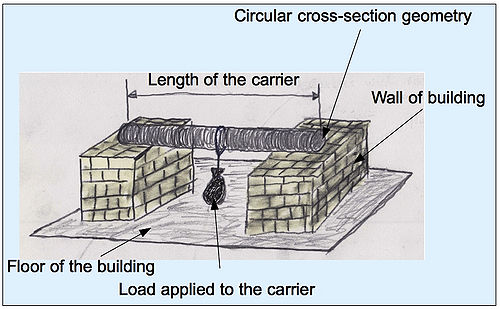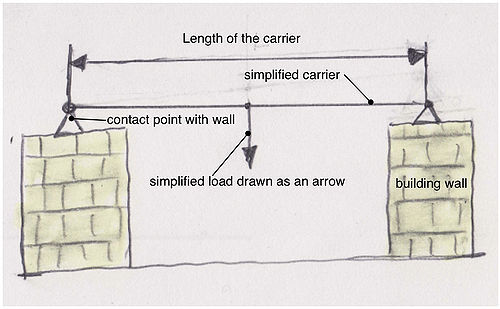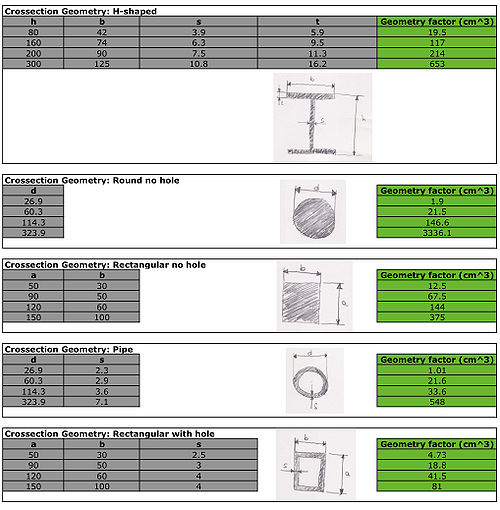Difference between revisions of "What Are Reasonable Spans of Carriers made of Various Materials"
HTP Petros (talk | contribs) |
HTP Petros (talk | contribs) |
||
| Line 42: | Line 42: | ||
Remember: A calculation is made so that some addtional safty for the construction is provided. This does not exclude collapse due to other external factors. Its is therefore of big importance to alway keep on eye on the construction and its state. The best thing that could be done would be to make a test by hanging a load of about the one that is expected finally under the condition that no one could get hurt so that one can be confident of the stability of the construction | Remember: A calculation is made so that some addtional safty for the construction is provided. This does not exclude collapse due to other external factors. Its is therefore of big importance to alway keep on eye on the construction and its state. The best thing that could be done would be to make a test by hanging a load of about the one that is expected finally under the condition that no one could get hurt so that one can be confident of the stability of the construction | ||
| − | === Examples of reasonable spans for | + | === Examples of reasonable spans for different Carriers=== |
| + | In the following table some examples of different carriers loaded as seen in figure 1 are presented. | ||
Revision as of 13:20, 16 February 2010
Contents
Common use of a carrier
At this part a simple method is presented for finding out if a carrier that is loaded with a weight at his midle has a resonable span or not. For this purpose some simple calculations have to be performed. In figure 1 one can see the carrier having a circular cross-section and a load in form of a sand bag at its middle. The carrier edges are supported from brick walls at each end on which they are fixed.
To simplify the problem figure 1 is remade as can be seen in figure 2
Three Main factors influencing the allowable span of a carrier
The important question arising is on which factors the carrier span depends? The allowable span of a carrier depends on three factors:
+ its cross-section geometry (see examples in figure 3 below)
+ its material (for instance steel, wood or reinforced concrete)
+ at which point the load is placed (e.g. is the load in the middle of the carrier or at an other point)
Remember: NEVER use concrete or similar brittle materials without reinforcements for a carrier! The possibility that it will colappse is almost certain!
The geometry factor
The dimensions of the cross section geometry are concentrated in a single value which forms the geometry factor (In engineering this factor is called area moment of inertia). For instance 100000 mm^4 in which mm^4 is a unit of measure for this factor (like meters or hours would be for length and time).
Notice that from the above mentioned cross-section geometrys the best choice conserning the weight of the carrier and its resistance to the loading in our case would be to use the "H-shaped" cross-section as for instance one can find in railroad tracks. Never the less it is more probable that you will find tree stems or wooden carriers with round or rectangular cross-section that also do the job very good.
A more detailed explanation on how the geometry factor is calculated can be found on Wikipedia: area moment of inertia. Nevertheless in most cases you can find the geometry factor from a table so that no further calculations are necessary.
The Material factor
As you may have experienced yourself every material has a certain strength. For instance if you take two rods of the same diameter one of wood and one of metal you will see that to brake the wooden rod in half would need much less effort than the metal rod. This shows that exactly the same carrier made of metal will for sure be able to resist to a much higher load than a the wooden one. This phenomenon is described using a certain number for each material (called yield stress). For instance for metal a value of 200 MPa is a comon value. MPa is a unit to measure this phenomenon (like meters or hours would be for length and time). A perfect reference for the values of the different carrier materials can be found under the site Wolfram aplha
where one just has to write "yield strength of YYYYY" where YYYY signifies a material like wood, steel or concreteThe Load Application factor
As we have shown in the above example the load is applied in the middle of the carrier. Never the less if it would be possible to apply the load instead of one point in the middle at several point of the carrier there would be a big benefit. Since distributed loading leads to smaller loads in the inside of the carrier and allows so higher spans. For the case of the sandsack this would mean that more ropes have to be applied or for the case of a roofing several vertical links would be needed.
Is finally the span reasonable or not?
<math> \sigma=\frac{M}{I} \cdot z_max</math>
<math>\sqrt{1-e^2}</math>
Remember: A calculation is made so that some addtional safty for the construction is provided. This does not exclude collapse due to other external factors. Its is therefore of big importance to alway keep on eye on the construction and its state. The best thing that could be done would be to make a test by hanging a load of about the one that is expected finally under the condition that no one could get hurt so that one can be confident of the stability of the construction
Examples of reasonable spans for different Carriers
In the following table some examples of different carriers loaded as seen in figure 1 are presented.
to be CONTINUED........ Notice: The author accepts no responsibility for the safety of a construction or the correctness of the article



